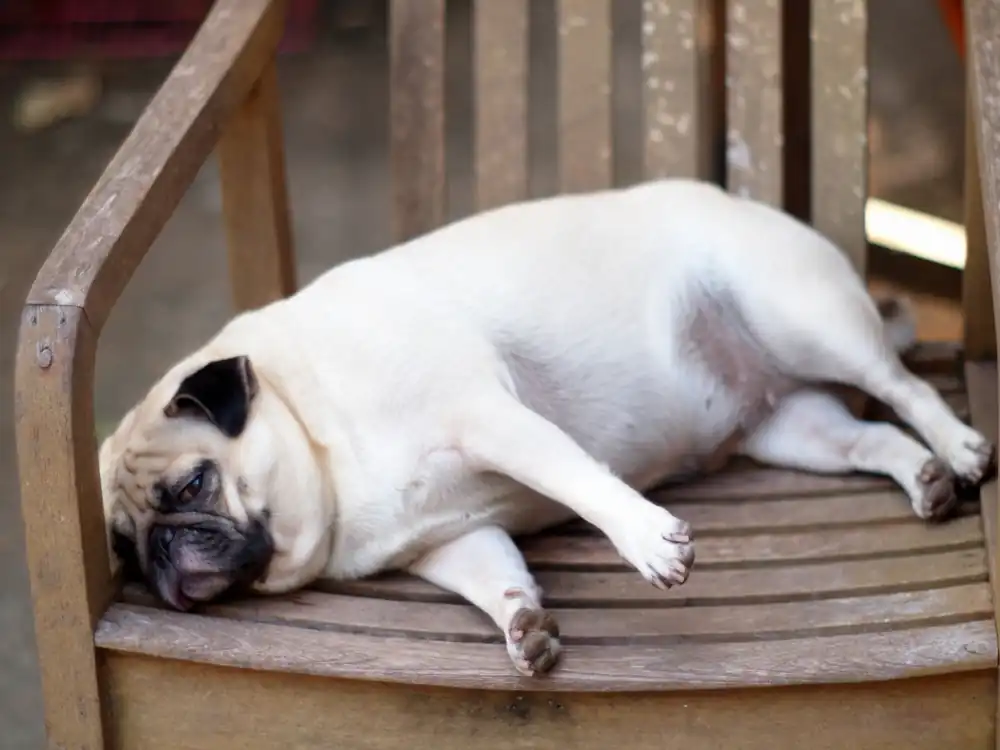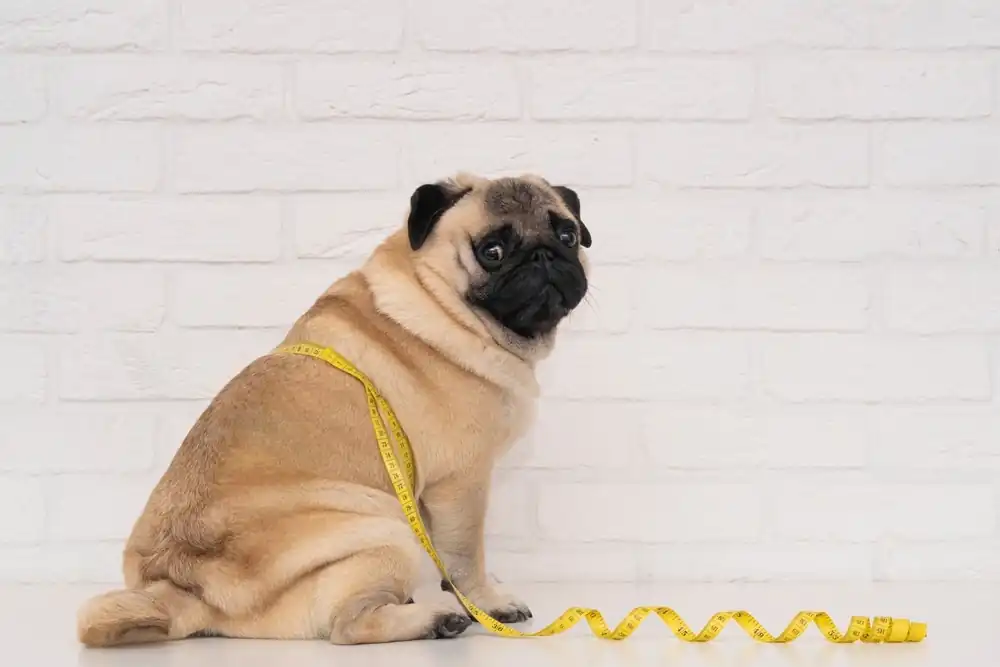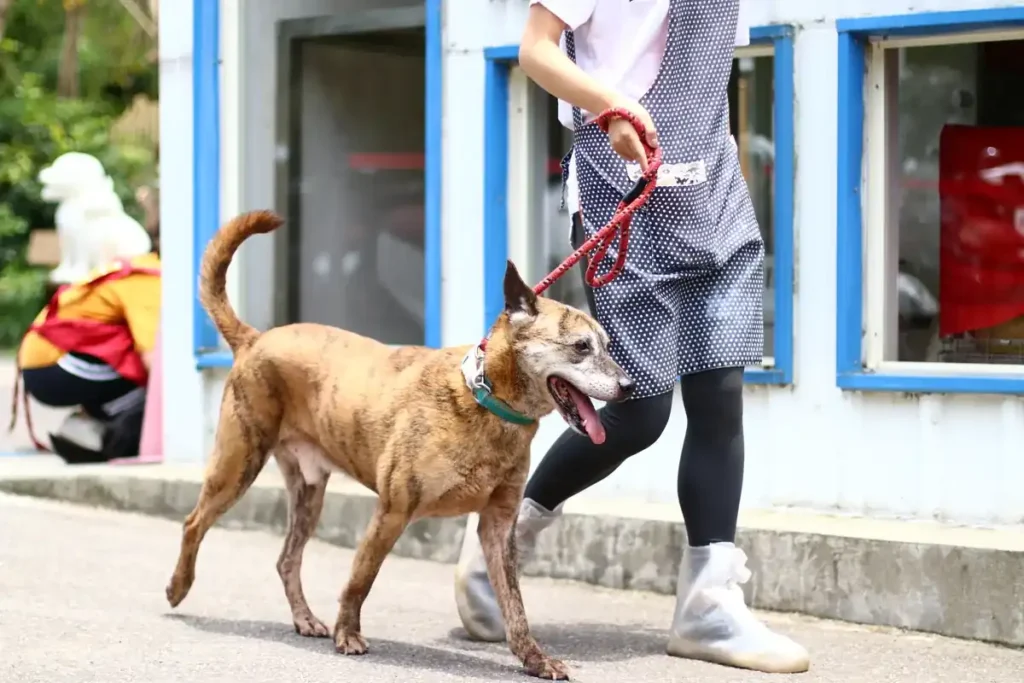A cute fat dog owned by a grand mom is the way to go? Beware of diseases!

When you go for a walk in the park, a lively, round and chubby dog is often the center of attention, after all, a fat dog’s fluffy and soft belly, overflowing tender meat between the fingers is always a favorite, who can resist a “grandma’s” cute fat dog?
But as an owner, have you ever paid attention to your dog’s physical condition? Frequent feeding of human food, rewarding snacks and other behaviors can make your dog fat, and there are research data showing that dogs have evolved an opportunistic diet, which means that when the owner overfeeds the dog, the dog tries to eat more and more, and all kinds of uncontrolled eating habits will reduce the life expectancy of the dogs.
Although the fat dog is very cute, but the dog is too fat but will greatly affect the dog’s health, if you want to let the dog with you for a long time, owners must do a good job of dog weight management. Next, let’s take a look at the standard weight of different dogs, to see if the dog has the problem of overweight!
(A) What is the standard weight for dogs? Use numbers to determine if your dog is overweight!
Since the standard for determining the size of a dog varies according to breed and height, before finding out the standard weight of a dog, you must let the dog stand on all fours on the ground and measure its height from the ground to the shoulders.
After measuring the height of the dog, you can further determine the size and standard weight of the dog, which can be roughly categorized into 4 types:
🐕Toy Dogs
Super miniature toy dogs are under 25cm in height and can be picked up with one hand, their small bodies are very appealing.
Common toy dog breeds include Pomeranian, Chihuahua, Maltese, Toy Poodle, Yorkshire, Butterfly Dog, etc. The appropriate weight for this type of dog is between 3-5 kilograms.
🐕Small Dogs
The height of small dogs is about 25-39cm. Common breeds include Miniature Doberman, Pug, French Bulldog, Bichon Frise, Cherokee, Shih Tzu, Dachshund, Cocker Spaniel, Jack Russell Terrier, Hiloti, etc. The weight of these dogs ranges from 6-11 kilograms.
🐕Medium-sized Dogs
Next is the more common medium-sized dog. Medium-sized dogs are about 40-64cm in height and have an average weight of 12-24kg.
The Shiba Shiba, a favorite dog, is a medium-sized dog. In addition to the Shiba Shiba, other breeds such as the Corgi, the Miguel, the Border Collie, the Doberman, the Bull Terrier, the Icelandic Sheepdog, and the Taiwanese Dog are also medium-sized dogs.
🐕Large Dogs
Last but not least, there is the majestic large dog, which is about 65-80cm tall and weighs about 25-45kg. Common large dog breeds include the Husky, Dalmatian, Mountain Dog, Great Pyrenees, Giant Poodle, Mastiff, Newfoundland, St. Bernard, Golden Retriever, Labrador, and Akita, etc. Understanding the size of your dog will help you to understand its physical condition.
Understanding your dog’s size is very important for weight management, and don’t think that your dog is just 1kg overweight. For a 25kg large dog, a 1kg increase in body weight is equivalent to a 65kg adult gaining 3kg; however, for a 10kg small dog, a 1kg increase in body weight is equivalent to a 65kg adult gaining 7kg! Therefore, as an owner, you must take good care of your dog’s physical condition in order to protect your dog’s health.
(B) Is my dog’s size standard? Touch here to know if your dog is overweight
Since the same breed of dog may have different body sizes, so in addition to mastering the body weight, you can further determine whether the dog is overweight by touching and observing. Generally speaking, the size of a dog can be categorized into three types: too thin, moderate, and too fat.
🐕Thin Dog Body Type
Visually, you can clearly see the lines of the ribs, lumbar vertebrae, and pelvis, and when you look down, the waist is obviously sunken inward, and you can hardly feel the fat wrapped around the dog’s ribs when you touch them with your hands.
It is recommended to supplement high energy food and water that can be easily absorbed and digested.
🐕Standard Dog Body Type
Observing the dog’s body shape, you can see the ribs, lumbar vertebrae, and pelvic lines are visible, the waist is slightly concave when looking down, and you can feel the spine and ribs with your hand, and there is a little bit of meat on the stomach, which is a good body shape.
This kind of dog body type is very standard, please continue to maintain!
🐕Overweight Dogs
The overweight type of dog is not only difficult to see the bones clearly, but also almost impossible to see the waist and abdominal lines, instead, you can find fat hoarding in the chest, spine, limbs or neck, no waist when looking down, the body is oval, and there is a full and soft abdomen.
The owner needs to use more force to touch the abdomen to feel the lines of the spine and ribs, or even not to feel the ribs at all.
If this is the case, it means that this is a fat dog, and it is recommended to improve the dog’s body shape through exercise and diet!
(C) 6 Reasons Why Dogs Get Fat!

After reading the above information, do you want to help your dog maintain a healthy body? Don’t worry, let’s take a look at the following information to help you find out the main reason why your dog is overweight.
🐕Out-of-control diet during puppyhood
With the advancement of medical science, the saying that “fat is not fat when you’re young” has long been disproved, even in pets.
Owners who let their dogs eat leftovers, use snacks to lure their puppies to eat feed, or prepare too much food when they are puppies will easily cause their dogs to “grow fat from small to large,” and eventually become overweight fat dogs.
Dr. Winston Faye reminds:
“Dogs that have obesity or overweight problems from puppyhood are likely to have obesity problems as adults.”
🐕Eating human food
The aroma of human food often makes dogs salivate, and when dogs look at their owners with big, watery eyes, many people can’t help but share some of the food in their hands with their dogs, which may seem harmless, but it will seriously affect the health of dogs in the long run.
Most human food is overly flavored, which is a great burden to the dog’s body and digestive tract, not only does it not bring the nutrients the dog needs, but it also carries the hidden risk of food poisoning and disease. For the sake of the dog’s health, no matter how cute the dog is, owners must restrain the urge to feed the dog.
🐕Overfeeding
When feeding your dog, you should not only feed your dog at a regular time and place, but also pay attention to not overfeeding your dog.
When feeding your dog, you need to check the recommended daily feeding amount on the package and adjust it according to your dog’s weight. In addition, it is not recommended to give the dog too many pet snacks to avoid the dog to take in too many calories, and gradually to the fat dog road ahead.
🐕Insufficient Exercise
Regular exercise is a great tool for dogs to slim down, whether it is walking, jogging, indoor ball throwing, swimming or hide-and-seek is a great sport for energetic puppies and large dogs, it is recommended to exercise more than 2 times a day, and for the older dogs and small dogs, morning and evening walks out 1 time to achieve the right amount of exercise.
In addition, according to a study by the Pet Insight Project, the obesity rate of adult dogs that exercise for more than 60 minutes a day is less than 50%, while the obesity rate of adult dogs that exercise for more than 80 minutes a day is less than 40%, which shows how important exercise is to the management of a dog’s weight.
🐕Neutering
Perhaps you have heard of the saying that dogs will gain weight after tying up, but why do dogs gain weight after tying up?
The reason is that after a dog is tied up, its body will lack the stimulation of sex hormones, which in effect reduces its activity level. Coupled with the fact that the hormonal changes cause it to eat a lot, under the dual incentive of “eating more and moving less”, many dogs end up becoming round and bulky.
However, although the ligature will make the dog easy to get fat, but not every dog’s weight will rise straight after the ligature, the most important thing is to control the diet and moderate exercise.
🐕Fat-prone Breeds
Did you know? Dogs also have a “fat-prone body”! According to a research report from a foreign journal, the absence of the POMC gene in Labrador’s body makes this breed easier to fall into the obesity crisis than other breeds, so if you keep a golden Labrador, you must pay special attention to its weight and don’t let it easily join the ranks of fat dogs!
After reading the above instructions, owners have discovered the real reason why the dog is too fat? Then let us continue to read down to understand an overweight fat dog may have what problems.
Attention overweight and fat dogs: Dogs are too fat to affect their health!

In industrialized countries, one in five dogs is overweight and fat, is your dog one of them?
Fur child is like our family, I believe that all the owners under the sky hope that their pets can accompany them a little longer, if you want to realize this wish, be sure to pay attention to the weight of the dog from now on, do not let the following diseases to find the overweight dog Oh!
Dr. Wen reminds:
“Studies have shown that the life expectancy of overweight dogs is shortened by up to two and a half years when compared to healthy weight dogs!”
(A) Diabetes in Dogs
Don’t think that dogs don’t have diabetes! Obese dogs that consume too many calories over a long period of time can suffer from high blood sugar, which in turn raises insulin production, and when the dog’s body can’t produce as much insulin, diabetes can result.
Symptoms of diabetes in dogs are very similar to those of humans, so when your dog eats more, drinks more, urinates more, and loses weight, be sure to take your dog to the veterinary hospital for further examination.
(B) Arthritis in dogs
Excessive weight will increase the burden on the dog’s joints, accelerating the wear and tear of the joints, and even injuring the bones, joints, muscles, and associated tendons and ligaments, leading to arthritis, which is usually found in older dogs such as grandmothers and granddaughters.
If the dog has joint problems, they may become more inactive, and when the lazy dog has the same amount of food, it can be imagined that it will make the weight increase, and aggravate the discomfort of their joints again, evolving into a vicious cycle.
(C) Cardiovascular disease in dogs
Excessive fat and cholesterol in the dog’s body will thicken the walls of the blood vessels around the heart, resulting in blood vessel blockage and increase the burden on the organs, so fat dogs are more prone to depression heart failure, hypertension and other problems.
(D) Respiratory Diseases in Dogs
An overweight dog’s chest will feel compressed, which will prevent the lungs from expanding effectively, increasing the burden on the body’s oxygen supply and causing the dog to pant.
(E) Calcium Oxalate Stones in the Urinary System of Dogs
Calcium oxalate stones form when the calcium and oxalate in your dog’s urine become saturated, affecting urination.
Generally speaking, obese dogs and small dogs drink less water and are more likely to have concentrated urine, which leads to a higher chance of developing bladder stones and, in more serious cases, may even cause kidney failure!
After reading so many diseases that fat dogs may have, I believe many owners have pinched a cold sweat for their own dogs! If you want to protect the health of your furry children and prolong their lives, follow the weight loss steps below to create a weight management program for fat dogs!
The 4 steps to help the dog to controll weight!
(A) fat dog to maintain the attitude of step 1: list the dog’s diet list
Obesity often stems from excessive calorie intake, if you want to control your dog’s weight, you must first list all the food that your dog will consume throughout the day, including meals, snacks, additional snacks and so on, and perhaps discover the core of the problem of the dog’s overweight.
(B) Maintaining a fat dog’s health Step 2: Setting the ideal weight and calculating calories
Once you know what your dog eats throughout the day, you can set a weight goal! But how many kilograms should the dog lose?
It is recommended that owners follow the standard weight of the dog as a goal, or discuss the ideal weight with the veterinarian, the initial period of weight loss can start from 0.5%-1% of the dog’s body weight in a week.
After setting the goal, we can use the table below to check your dog’s daily calorie requirement (RER):
| Ideal Body Weight (kg) | Daily calorie requirements | Ideal Body Weight (kg) | Daily calorie requirements |
| 4.5 | 210 | 24.9 | 820 |
| 6.8 | 270 | 27.2 | 890 |
| 9 | 340 | 29.4 | 950 |
| 11.3 | 410 | 31.7 | 1020 |
| 13.6 | 480 | 34 | 1090 |
| 15.8 | 550 | 36.2 | 1160 |
| 18 | 615 | 38.5 | 1230 |
| 20 | 680 | 40.8 | 1300 |
| 22.6 | 750 | 43.9 | 1430 |
Then the owner can follow this figure to feed the dog, it is recommended that owners can match with electronic scales or smart bowls with the function of calculating the weight to weigh the dog’s feed, in order to better grasp the amount of food.
(C) Maintaining a fat dog’s health Step 3: Healthy and moderate diets
Feeding your dog may seem simple, but do you know how to feed your dog in order to keep it healthy and control its weight? Here are 3 tips for feeding your dog!
🐕Small portions and slow feeding
When feeding your dog, it is recommended to divide the food into two meals and use a feeding bowl with a protruding bottom to not only reduce your dog’s desire to eat, but also to slow down their eating speed.
🐕Control the amount of snacks
Dogs are always begging for food, but too many snacks are often the real culprit of dog fat, so owners must pay attention to the amount of food when feeding their dogs snacks.
Some owners will grab the correct amount of feed and reserve some of it for the dog’s snacks for the day, which allows the dog to eat the snacks without exceeding the calorie intake for each meal. If the owner has to buy additional dog snacks, then the snacks should be limited to 10% of the total daily calories, and reduce the meal portion accordingly.
🐕Choose a weight management diet for your dog
General dog feed is mainly composed of protein and carbohydrates, supplemented by other nutrients. If you want to control your dog’s diet, it is recommended that you purchase a weight management dog feed.
Dog weight management feeds have a high protein, low fat ratio, along with some fiber blends, can use lower calories to bring the dog a sense of satiety, in the diet control at the same time take into account the nutritional balance, is the best choice for dogs to achieve a healthy body.
(D) Fat dog to maintain the physical condition of step 4: regular, moderate exercise
Owners in the control of the furry children’s diet, do not forget to bring them together exercise Oh! Moderate exercise and daily walks with your dog can help your dog find its ideal body shape.
Below is a list of walking frequencies and times for different sizes of dogs for reference by owners, who can also adjust the frequency and time of walks according to the dog’s physical condition.
| small dog | medium sized dog | large dog | |
| Number of daily walks | 1-2 times | 2 times | 2-3 times |
| Time per walk | Approx. 5-10 minutes | About 20-30 minutes | About 60 minutes |

What are some of the activities that can be done on a walk? If your dog is still very young, then swimming, jogging, long distance ball throwing and catching Frisbees with the owner can effectively exercise your dog’s body.
For older dogs, intense exercise may not be suitable for them. It is recommended to take at least one walk a day, throw a ball over a short distance to help the dog exercise, or buy some educational toys for dogs so that even if the owner is not at home, the dog can still play with the toys to consume calories and activate its brain.
Finally, if it rains, owners can play hide-and-seek or tug-of-war with their dogs indoors.
After reading such a wealth of dog slimming tips, do all owners want to help their chubby dogs control their weight? While exercising with your dog, don’t forget to find the right nutritional formula for your dog in conjunction with dietary control!
